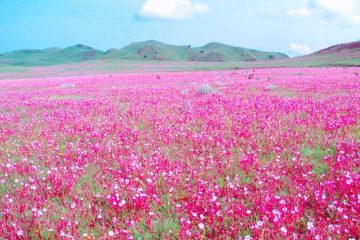Kitulo National Park
 Perched at around 2600 meters above sea level between the rugged peaks of the Kipengere, Poroto and Livingstone mountains, the well-watered volcanic soils of Kitulo support the largest and most important montane grassland community in Tanzania. Referred by locals as The Garden of God, Kitulo National Park is “one of the great floral spectacles of the world”, a rare botanical marvel and home to 350 species of vascular plants, including 45 varieties of terrestrial orchid, which erupt into a riotous wildflower display of breathtaking scale and diversity during the main rainy season of late November to April.
Perched at around 2600 meters above sea level between the rugged peaks of the Kipengere, Poroto and Livingstone mountains, the well-watered volcanic soils of Kitulo support the largest and most important montane grassland community in Tanzania. Referred by locals as The Garden of God, Kitulo National Park is “one of the great floral spectacles of the world”, a rare botanical marvel and home to 350 species of vascular plants, including 45 varieties of terrestrial orchid, which erupt into a riotous wildflower display of breathtaking scale and diversity during the main rainy season of late November to April.
One of the most important watersheds for the Great Ruaha River, Kitulo is also the first national park in tropical Africa to be gazetted largely for its floral significance-not only a multitude of orchids, but also the stunning yellow-orange red-hot poker and a variety of aloes, proteas, geraniums, giant lobelias, lilies and aster daisies, of which more than 30 species are endemic to southern Tanzania. But Kitulo is also attractive for bird watching, home to rare bird species. Big game is sparsely represented, though a few hardy mountain reedbuck and eland still roam the open grassland. Located about 100 kilometres from Mbeya town in Southern Tanzania, Kitulo National Park (413 sq km) is a botanist and hiker’s paradise. Wild flowers displays peak during the rainy season between December and April excellent time for botanists, while the sunnier months of September to November are more comfortable for hiking but less rewarding to botanists. Conditions are cold and foggy from June to August. Accommodation is available in Mbeya town.
FLORA IN THE NATIONAL PARK
Botanists call the Kitulo Plateau the “Serengeti of Flowers” because it is home to one of the largest flower deposits in the world. In total around 400 plant species live in the montane grasslands. The plateau has more than 45 species of orchids, geophytes, aloes, proteas, geraniums, giant lobelia, lilies and aster daisies and other afro-alpine plants. These mountain meadows are florishing during the rainy season from November to April. You can find many species only in the Kipengere Mountains and the nearby highlands. Brachystelma kituloensis, Impatiens rosulata, and Pterygodium Ukingense can only be found in the Kitulo National Park.
WILDLIFE IN KITULO PLATEAU NATIONAL PARK
Except for a few mountain reedbucks and eland, the occurrence of large animals in Kitulo is not very large. But plants, birds and butterflies make up for life in the park. The rare chimpanzee, blue swallow, red chalk hawk, njembe stalksinger, kipengere seedeater, mountain swamp widow, zebra, kipunji monkey, chameleon, lizards, frogs, spiders and other small insects are native to the park.
CLIMATE
The climate is influenced by altitude, Lake Nyasa and is largely temperate. The maximum daily temperature varies from 14.5°c to 18°c and minimum ambient temperature ranges from 7°c to 8°c between December and April, and can go as low as 0.5˚c during June to August ,during this period frost occurs. The average annual rainfall is 1600mm ranging from 1500 – 1700mm. The rain season begins from October to May.
Park Attractions inside the Park
These are places of interest inside the park, where t ourists can visit, typically for its inherent or exhibited natural or cultural value, historical significance, natural or built beauty, offering leisure, adventure and amusement.
The Park has vast expanses of rolling upland grassland, rounded hills stretching away to the horizon, waterfalls, rivers and crater lake.
Mount Livingstone Forest
Some of the tree species in the forest are Hagenia abyssinica, Ocotea usambarensis, Juniperus procera, and Khaya anthoceca. The forest is also characterised by mountain Bamboo, (Sinarundinaria alpina). Kitulo is rich in flora species with 350 species of high plants recorded, including 45 species terrestrial Orchids, of which 31 species are endemic to Tanzania, 16 are endemic to Kitulo and Poroto Mountain sand at least 3 species are endemic to Kitulo national park. Two species are only known to be in Kitulo and adjoining forest. The abundance of plants in the wet season has been described as the greatest flora marvel of the World.
Cultural Attractions
Mlivili cave is located along Matamba Ridge after Mwakipembo water fall and Usalama cave is about 8 kilometers away from Common works Junction, the road to Mbeya via Isyonje. During those days of intertribal war, the caves were used as the hiding point by indigenous people from Wawanji, Wakinga and Nyakyusa from Mwakaleli. Now days, these area are used as poachers hides.
Birds
Kitulo National Park is an important bird area (IBA) with wintering site for various bird species from South Africa and Europe. Some species from North Africa, Abdim’s stock in particular use Kitulo as a wintering area. The plateau is also a home of breeding colonies of Blue swallow and Denham’s bustard. Other endemic bird’s species includes: Lesser kestrel, Pallid Harrier, Cisticola njombe, Kipengere Seedeater and Uhehe fiscal. A number of waterbirds can be found at Dhambwe Crater Lake. These are: Yellow billed-duck, White-faced whistling ducks, Common teal, Open-billed stocks and Red knobbed coot.
Nhumbe Valley
This is often referred as the jewel of the Park, where small streams emerge from the grassy hill sides sometimes cascading down in little waterfalls, thus forming the head waterfall for Nhumbe river, one of the main tributary of the Great Ruaha River. The gap of the valley is occupied by Juniper forest, one of the most extensive in East Africa. They tower to 50 m high and are indeed the tallest junipers in the world.
 info@dsmtourssafaris.co.tz
info@dsmtourssafaris.co.tz +255 713 236 844 / +255 753 236844 / +255 677 787352
+255 713 236 844 / +255 753 236844 / +255 677 787352 Jamhuri Street Near Golden Tulip Hotel City Center, Dar es Salaam
Jamhuri Street Near Golden Tulip Hotel City Center, Dar es Salaam




